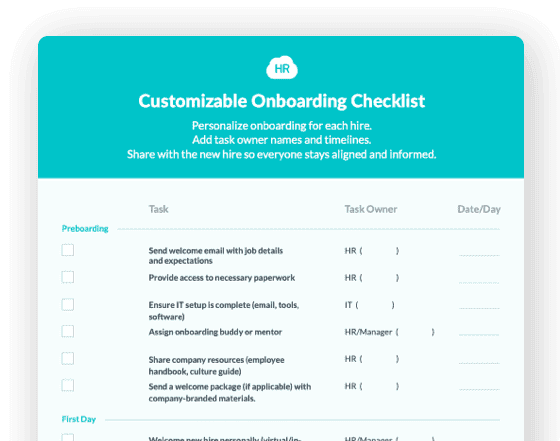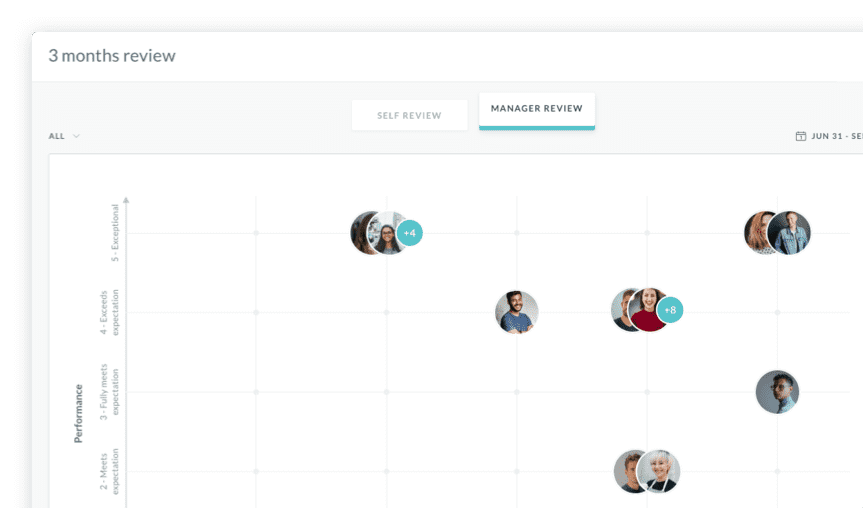9 Ways to Make Your Feedback More Constructive and Actionable
.png)


 Cut onboarding time
by 60%—here's the
Ultimate Checklist
that helped do it.
Cut onboarding time
by 60%—here's the
Ultimate Checklist
that helped do it.

Giving feedback in the workplace is tricky – even if you're an experienced manager or HR professional. Use the wrong tone or approach, and you could alienate an employee, resulting in poor performance, decreased morale, or increased turnover.
Despite many people finding this difficult, feedback is a critical tool for improving performance, increasing engagement, and retaining employees.
Chances are, your employees want feedback more than you think. But it goes without saying that people will respond better to constructive feedback. So, we've created this guide to show managers and team leaders how to make your feedback constructive and actionable.
Whether for performance, behavior, or attitude, this guide will help you structure your feedback clearly and positively.
Is Your Company's Culture
Working Against You?
culture with our short quiz.
What is Constructive Feedback?
Feedback is verbal or non-verbal communication that informs a person about their behavior, attitude, or performance. The process provides input and evaluation to individuals or groups, showing you recognize their strengths while highlighting areas for improvement.
Feedback can be immediate or delayed. There are also different types of feedback, including constructive feedback.
Constructive feedback focuses on providing helpful and actionable suggestions for improvement. It aims to guide and support recipients in enhancing their skills, performance, or behavior.
Unlike negative or destructive feedback, which may solely criticize or demotivate, constructive feedback offers specific recommendations, insights, or observations to help the individual or group grow and develop.
9 Tips to Make Your Feedback More Constructive and Actionable
Giving feedback can be awkward if you're new at it. But with practice and the right mindset, it's doable.
Remember to live by example if you want your constructive criticism to have an impact. With that in mind, here are nine ways to make your feedback constructive.
1. Choose the Right Place and Time
Where and when you provide feedback can significantly impact the recipient's reaction. Praise and commendations during team meetings are always appreciated. On the other hand, criticism in a public setting can be embarrassing and humiliating.
Any criticism should be done in private and praise in public. Put yourself in the employee’s shoes. If your superior called you out in front of everyone, how would that make you feel? Undoubtedly, not so great. So it’s advisable to keep your emotions in check and only reprimand privately.
Timing is another crucial factor that influences the receiver's reception to feedback.
It’s best to give feedback immediately. The longer you wait, the trickier it can be. As soon as you're sure you can offer a constructive comment, do it.
2. Be Emotionally Intelligent
Speaking of the timing of your feedback, you want to really get this on the money. That's why emotional intelligence can be the difference maker. For instance, with EQ, you realize you shouldn't give feedback when the receiver is in a foul mood.
Knowing the most appropriate medium to communicate is equally important. Giving constructive feedback in person rather than via email or Slack is better. This is because some words are better spoken than written and you don’t want your message to be misunderstood.

For example, “I’ve noticed that you are usually absent from team meetings. Could there be a legitimate reason for this?” sounds less confrontational verbally than in writing.
A call forwarding service for small business can also be valuable here, especially if you manage remote teams. Take advantage of modern platforms like this as they offer excellent flexibility and are vital communication tools. As a result, you can directly convey comments to employees whenever necessary.
3. Lead With the Positive
A smart way to give constructive feedback to someone is first to make them feel appreciated. This sets the tone for the conversation and affects how they're going to react.
One way to balance this is by employing the sandwich approach. The is a popular feedback technique that involves sandwiching negative feedback between two positive comments.
For example, "I really appreciate your dedication and hard work on this project, but I noticed a few errors in your report. However, I know you're capable of doing better, and I look forward to seeing your improved work."
This approach helps soften the blow of negative feedback and keeps the conversation positive. Moreover, it gives the employee direction, so they can walk away from your feedback feeling empowered and motivated to improve.
4. Be Clear and Direct (but diplomatic)
Constructive feedback should be specific and objective. Avoid generalizations or subjective comments that may be interpreted differently. Instead, focus on the specific behavior or action that needs improvement.
For example, instead of "You need to improve your communication skills," you can say, "During the last team meeting, you interrupted your colleagues several times. Could you try to listen more actively and avoid interrupting in the future?"
This not only helps the employee understand what they need to do better, but it also shows that you have spent time analyzing their work and offering thoughtful feedback.
5. Engage the Recipient in Dialogue
Employee feedback should not be a one-way conversation; employees should be able to contribute. Allow the employee to speak after giving the context, purpose, observations, and details.
This allows you to gain a new perspective on the event in question.
For a positive outcome, engage in active listening. Active listening is essential for giving and receiving feedback. It involves listening to understand rather than listening to respond.
Give the receiver your full attention, ask open-ended questions, and summarize what you heard to ensure understanding.

6. Be Respectful and Stay on Topic
It’s essential to be respectful throughout a meeting when dealing with a staff member. When giving feedback, focus on employee behavior, not personality.
For example, instead of saying, "You're lazy," you could say, "I noticed you haven't been meeting your deadlines lately. Can you tell me what's going on?" This approach is less aggressive and more likely to elicit a productive conversation.
7. Offer to Develop Solutions Together
Constructive feedback is not just about pointing out problems but also about employees and managers collaborating on solutions. Encourage the receiver to share their perspective and ideas on how to improve.
Rather than “Your presentation was a letdown,” you could say, “Let’s see how we can work together to make your presentation more engaging by adding visuals and interactive elements”.
It shows the employee that you are invested in their success and gives them a clear path forward.
8. Be Open to Feedback Yourself
As mentioned, feedback is a two-way street. Employees will respond positively if you are open to feedback yourself.
Encourage your employees to share their thoughts and suggestions with you, and be willing to listen and make changes based on their feedback. The result is an open communication and continuous improvement culture.
9. Follow up
After giving feedback, follow up with the employee to monitor their progress. For instance, if you discussed improving the employee's presentation skills, you could ask how they are preparing for their next presentation and if they need any assistance.
In this way, you are demonstrating your commitment to their success and keeping them accountable. It's also an excellent opportunity to offer additional feedback or support.
Constructive Feedback has Many Benefits
It’s never easy to give feedback. But when it's executed well, the result can positively impact your employee's performance and the bigger picture. Knowing how to provide constructive feedback is an invaluable skill.
The tips we've shared above will help you give constructive feedback that your employees will appreciate. Remember, people appreciate feedback when it’s crafted positively and you, too, remain open to constructive feedback.
Author Bio:
This article is written by a marketing team member at HR Cloud. HR Cloud is a leading provider of proven HR solutions, including recruiting, onboarding, employee communications & engagement, and rewards & recognition. Our user-friendly software increases employee productivity, delivers time and cost savings, and minimizes compliance risk.
Keep Reading
45 Boss Day Messages That Actually Mean Something (2026 Guide)
When is Boss Day 2026? Mark your calendar for October 16, 2026 — the annual opportunity
Birthday Wishes for Coworkers: 50+ Messages That Build Workplace Connection
A coworker's birthday isn't just another calendar date—it's a meaningful opportunity to
Embracing Diversity: Recognizing Different Cultures in the Workplace
Workplaces today reflect the incredible diversity of the world around us. People bring
Like What You Hear?
We'd love to chat with you more about how HR Cloud® can support your business's HR needs. Book Your Free Demo

Build a Culture of Recognition. Boost Engagement. Guaranteed.
Workmates empowers employees to stay informed, connected, and appreciated—whether they’re on the front line, in the office, or remote. Recognition drives 12x higher engagement.Trusted by industry leaders in every sector




Cut Onboarding Costs by 60%.
Take the confusion and follow-ups out of onboarding with automated workflows, digital forms, and structured portals—so new hires ramp faster 3X quicker.Trusted by industry leaders in every sector





